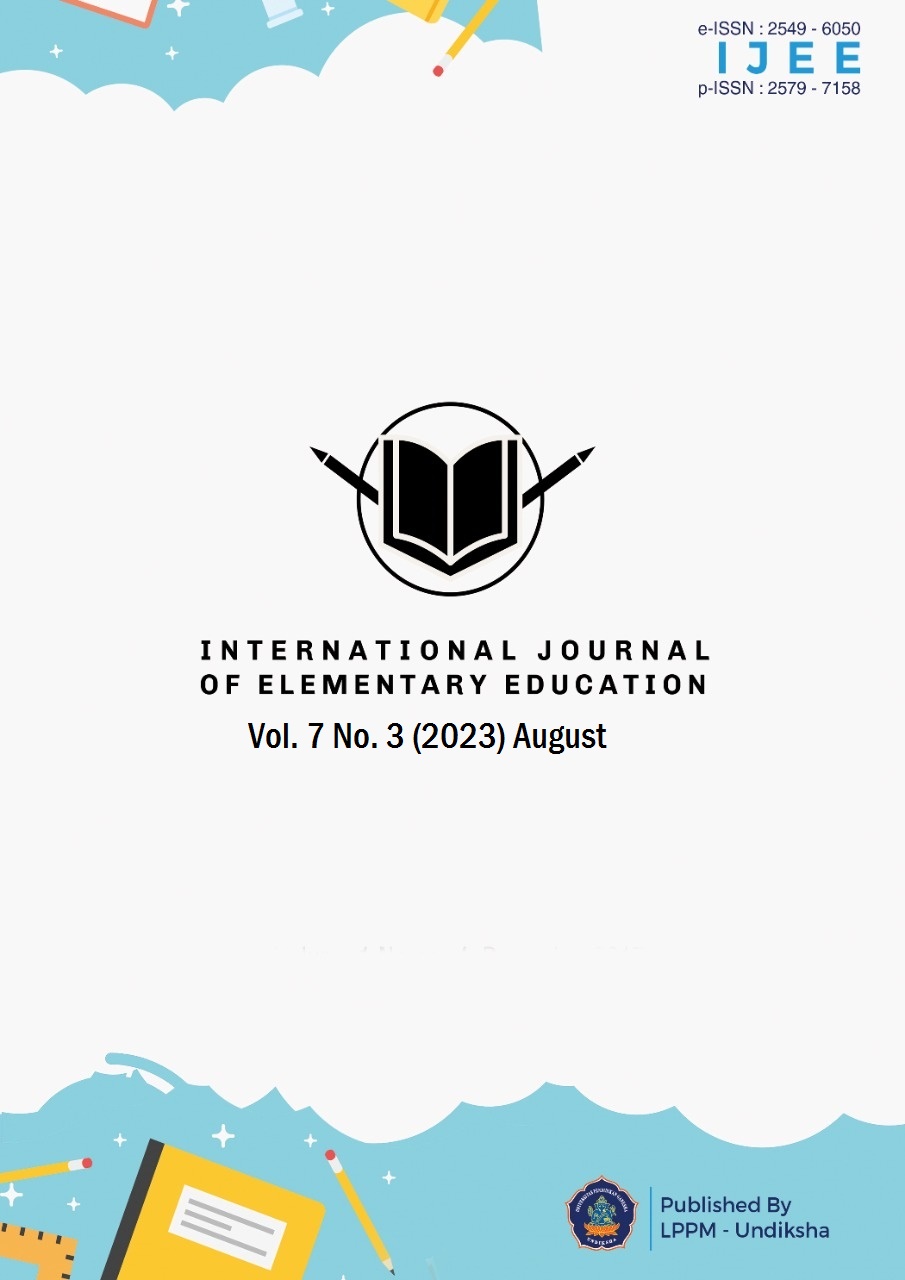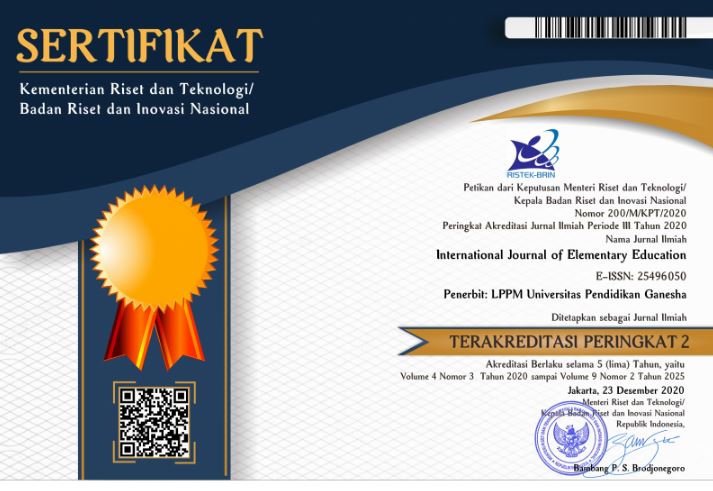3D Interactive Multimedia with a Contextual Approach in English Subjects
DOI:
https://doi.org/10.23887/ijee.v7i3.60473Keywords:
ADDIE Model, Interactive Multimedia, Contextual ApproachAbstract
Various technological improvements were developed to be able to help achieve each material competency in learning. This study aims to: (1) find out the design and development of interactive multimedia with a contextual approach, (2) find out the validity of interactive multimedia with a contextual approach (3) find out the effectiveness of interactive multimedia with a contextual approach in English. This type of research is development using the ADDIE model. Data collection was carried out by recording documents, interviews, questionnaires and tests. The data analysis used is descriptive qualitative analysis, quantitative and inferential statistics. The results of this study are (1) Interactive multimedia is developed using the ADDIE model through 5 stages (analyze, design, development, implementation, evaluation); (2) the validity of interactive multimedia based on the results of the review by content experts and media experts was 96%, the results of the design expert's review were 94.66%, the results of individual trials were 95.88% and small group trials were 98.2% ( 3) the effectiveness of interactive multimedia shows an average pre-test of 52.2 and a post-test score of 81.9. After calculating using the t-test, the results obtained are t-count of 12,595 > t-table 2,074. So H0 is rejected and H1 is accepted. Thus, interactive multimedia with a contextual approach which was developed is effective for improving students' learning outcomes in English.
References
Abdulrahaman, M. D., Faruk, N., Oloyede, A. A., Surajudeen-Bakinde, N., T., Olawoyin, L. A., Mejabi, O. V., Imam-Fulani, Y. O., Fahm, A. O., & Azeez, A. L. (2020). Multimedia tools in the teaching and learning processes: A systematic review. Heliyon, 6(11), e05312. https://doi.org/10.1016/j.heliyon.2020.e05312. DOI: https://doi.org/10.1016/j.heliyon.2020.e05312
Aldoobie, N. (2015). ADDIE Model. American International Journal of Contemporary Research, 5(6). www.aijcrnet.com/journals/Vol_5_No_6_December_2015/10.pdf.
Armansyah., & Sulthoni. (2019). Multimedia Interaktif Sebagai Media Visualisasi Dasar-Dasar Animasi. Jurnal Kajian Teknologi Pendidikan, 2(3), 224–229. https://doi.org/10.17977/um038v2i32019p224. DOI: https://doi.org/10.17977/um038v2i32019p224
Bond, M., Marín, V. I., Dolch, C., Bedenlier, S., & Zawacki-Richter, O. (2018). Digital transformation in German higher education: student and teacher perceptions and usage of digital media. International Journal of Educational Technology in Higher Education, 15(1), 1–20. https://doi.org/10.1186/s41239-018-0130-1. DOI: https://doi.org/10.1186/s41239-018-0130-1
Bustanil S, M., Asrowi, & Adianto, D. T. (2019). Pengembangan Media Pembelajaran Interaktif Berbasis Video Tutorial Di Sekolah Menengah Kejuruan. JTP - Jurnal Teknologi Pendidikan, 21(2), 119–134. https://doi.org/10.21009/jtp.v21i2.11568. DOI: https://doi.org/10.21009/jtp.v21i2.11568
Eren, A., & Coskun, H. (2016). Students’ level of boredom, boredom coping strategies, epistemic curiosity, and graded performance. Journal of Educational Research, 109(6), 574–588. https://doi.org/10.1080/00220671.2014.999364. DOI: https://doi.org/10.1080/00220671.2014.999364
Fahmi, A. N., Yusuf, M., & Muchtarom, M. (2021). Integration of Technology in Learning Activities: E-Module on Islamic Religious Education Learning for Vocational High School Students. Journal of Education Technology, 5(2), 282–290. https://doi.org/10.23887/jet.v5i2.35313. DOI: https://doi.org/10.23887/jet.v5i2.35313
Fu, L., Sun, Z., Zha, L., Liu, F., He, L., Sun, X., & Jing, X. (2020). Environmental awareness and pro-environmental behavior within China’s road freight transportation industry: Moderating role of perceived policy effectiveness. Journal of Cleaner Production, 252(1), 1–30. https://doi.org/10.1016/j.jclepro.2019.119796. DOI: https://doi.org/10.1016/j.jclepro.2019.119796
Handayani, D. (2020). Pemanfaatan Youtube pada saat pandemi COVID-19 untuk media pembelajaran Bahasa Inggris dalam meningkatkan vocabulary dan pemahaman siswa. JUPENDIK: Jurnal Pendidikan, 4(2), 12–18. https://jupendik.or.id/index.php/jupendik/article/view/33.
Hau, N. H., Cuong, T. V., & Tinh, T. T. (2020). Students and Teachers’ Perspective Of The Importance Of Arts In STEAM Education In Vietnam. Journal of Critical Reviews, 7(11), 666–671. https://doi.org/10.31838/jcr.07.11.121.
Hayati, F., Neviyarni, N., & Irdamurni, I. (2021). Karakteristik Perkembangan Siswa Sekolah Dasar: Sebuah Kajian Literatur. Jurnal Pendidikan Tambusai, 5(1), 1809–1815. https://www.jptam.org/index.php/jptam/article/download/1181/1056.
Heri Suryaman, Kusnan, & Husni Mubarok. (2020). Profile of Online Learning in Building Engineering Education Study Program During the COVID-19 Pandemic. IJORER : International Journal of Recent Educational Research, 1(2), 63–77. https://doi.org/10.46245/ijorer.v1i2.42. DOI: https://doi.org/10.46245/ijorer.v1i2.42
Ibrahem, U. M., & Alamro, A. R. (2020). Effects of Infographics on Developing Computer Knowledge, Skills and Achievement Motivation among Hail University Students. International Journal of Instruction, 14(1), 907–926. https://doi.org/10.29333/IJI.2021.14154A. DOI: https://doi.org/10.29333/iji.2021.14154a
Karo-Karo, I. R., & Rohani, R. (2018). Manfaat Media dalam Pembelajaran. AXIOM : Jurnal Pendidikan Dan Matematika, 7(1), 91–96. https://doi.org/10.30821/axiom.v7i1.1778. DOI: https://doi.org/10.30821/axiom.v7i1.1778
Kurnia, T. D., Lati, C., Fauziah, H., & Trihanton, A. (2019). Model ADDIE Untuk Pengembangan Bahan Ajar Berbasis Kemampuan Pemecahan Masalah Berbantuan 3D. Seminar Nasional Pendidikan Matematika, 1(1), 516–525. http://www.fkip-unswagati.ac.id/ejournal/index.php/snpm/article/view/844.
Kusumawati, L. D., Sugito, Nf., & Mustadi, A. (2021). Kelayakan Multimedia Pembelajaran Interaktif Dalam Memotivasi Siswa Belajar Matematika. Kwangsan: Jurnal Teknologi Pendidikan, 9(1), 31. https://doi.org/10.31800/jtp.kw.v9n1.p31--51. DOI: https://doi.org/10.31800/jtp.kw.v9n1.p31--51
Maili, S. N., & Hestiningsih, W. (2017). Masalah-Masalah Pembelajaran Bahasa Inggris Pada Sekolah Dasar. Media Penelitian Pendidikan : Jurnal Penelitian Dalam Bidang Pendidikan Dan Pengajaran, 11(1), 54–62. https://doi.org/10.26877/mpp.v11i1.2607. DOI: https://doi.org/10.26877/mpp.v11i1.2607
Marchetti, L., & Cullen, P. (2015). A Multimodal Approach in the Classroom for Creative Learning and Teaching. Psychological and Creative Approaches to Language Teaching, 39–51. https://doi.org/10.1016/j.bbalip.2011.04.004. DOI: https://doi.org/10.1016/j.bbalip.2011.04.004
Mariyah, Y. S., Budiman, A., Rohayani, H., & Audina, W. D. (2021). Meningkatkan Motivasi Belajar Siswa Melalui Pemanfaatan Media Audio Visual : Studi Eksperimen Dalam Pembelajaran Tari. Journal of Education, Humaniora and Social Sciences (JEHSS), 4(2), 959–967. https://doi.org/10.34007/jehss.v4i2.778. DOI: https://doi.org/10.34007/jehss.v4i2.778
Maryani, I., Prasetyo, Z. K., Wilujeng, I., & Purwanti, S. (2022). Higher-order Thinking Test of Science for College Students Using Multidimensional Item Response Theory Analysis. Pegem Egitim ve Ogretim Dergisi, 12(1), 292–300. https://doi.org/10.47750/pegegog.12.01.30. DOI: https://doi.org/10.47750/pegegog.12.01.30
Miftah, M. (2014). Pemanfaatan Media Pembelajaran Untuk Peningkatan Kualitas Belajar Siswa. Jurnal Kwangsan, 2(1), 1. https://doi.org/10.31800/jurnalkwangsan.v2i1.11. DOI: https://doi.org/10.31800/jurnalkwangsan.v2i1.11
Nurrita. (2018). Pengembangan Media Pembelajaran Untuk Meningkatkan Hasil Belajar Siswa. Misykat, 3, 171–187. https://pdfs.semanticscholar.org/9642/924d69e47d2aaaa01c9884a402c34a7bf13f.pdf.
Phejane, M. V. (2022). A case study on the advantages and disadvantages of using blackboard collaborate in the health sciences faculty at the University of the Free State. The Independent Journal of Teaching and Learning, 17(1), 151–166. https://doi.org/https://hdl.handle.net/10520/ejc-jitl1-v17-n1-a11.
Ramadhani, V. Y., & Khusniati, M. (2022). Development of Interactive E-Books containing Virtual Laboratory to Improve Students’ Motivation Learning. Journal of Environmental and Science Education, 2(1), 49–57. https://doi.org/10.15294/jese.v2i1.53125. DOI: https://doi.org/10.15294/jese.v2i1.53125
Renes, S. L., & Strange, A. T. (2010). Using Technology to Enhance Higher Education. Innovative Higher Education, 36(3), 203–213. https://doi.org/10.1007/s10755-010-9167-3. DOI: https://doi.org/10.1007/s10755-010-9167-3
Reyna, J., Hanham, J., & Meier, P. (2017). A taxonomy of digital media types for Learner-Generated Digital Media assignments. E-Learning and Digital Media, 14(6), 309–322. https://doi.org/10.1177/2042753017752973. DOI: https://doi.org/10.1177/2042753017752973
Roemintoyo, R., & Budiarto, M. K. (2021). Flipbook as Innovation of Digital Learning Media: Preparing Education for Facing and Facilitating 21st Century Learning. Journal of Education Technology, 5(1), 8. https://doi.org/10.23887/jet.v5i1.32362. DOI: https://doi.org/10.23887/jet.v5i1.32362
Rustandi, A., & Rismayanti. (2021). Penerapan Model ADDIE dalam Pengembangan Media Pembelajaran di SMPN 22 Kota Samarinda. Jurnal Fasilkom, 11(2), 57–60. https://doi.org/10.37859/jf.v11i2.2546. DOI: https://doi.org/10.37859/jf.v11i2.2546
Sapriyah. (2019). Pembelajaran Dalam Proses Belajar Mengajar. Prosiding Seminar Nasional Pendidikan FKIP, 2(1), 470–477. http://jurnal.untirta.ac.id/index.php/psnp/article/view/5798.
Schunk, D. H., & DiBenedetto, M. K. (2020). Motivation and social cognitive theory. Contemporary Educational Psychology, 60, 101832. https://doi.org/10.4103/0019-5154.182410. DOI: https://doi.org/10.1016/j.cedpsych.2019.101832
Shebastian, I. G. R. ., Suyasa, I. M. S., & Arta, P. . (2020). Pengembangan Media Pembelajaran Interaktif “ Pengenalan Hewan Dan Tumbuhan ” Pada Mata Metode Gamefikasi Untuk Siswa Kelas Ii Di Sekolah Dasar. Karmapati, 9(1), 8–20. https://doi.org/10.23887/karmapati.v9i1.23270.
Sugiharto, T. (2016). Rancang Bangun Pengembangan Aplikasi Pembelajaran Bahasa Inggris Berbasis Multimedia Interaktif. JEJARING: Jurnal Teknologi Dan Manajemen Informatika, 1(1). https://doi.org/10.25134/jejaring.v1i1.292.
Tafonao, T. (2018). Peranan Media Pembelajaran Dalam Meningkatkan Minat Belajar Mahasiswa. Jurnal Komunikasi Pendidikan, 2(2), 103. https://doi.org/10.32585/jkp.v2i2.113. DOI: https://doi.org/10.32585/jkp.v2i2.113
Tegeh, I. M. dan I. M. K. (2010). Metode Penelitian Pengembangan Pendidikan. Universitas Pendidikan Ganesha.
Torres-Gastelú, C. A., & Kiss, G. (2016). Perceptions of students towards ICT competencies at the University. Informatics in Education, 15(2), 319–338. https://doi.org/10.15388/infedu.2016.16 DOI: https://doi.org/10.15388/infedu.2016.16
Whale, K., Cramer, H., & Joinson, C. (2018). Left behind and left out: The impact of the school environment on young people with continence problems. British Journal of Health Psychology, 23(2), 253–277. https://doi.org/10.1111/bjhp.12284. DOI: https://doi.org/10.1111/bjhp.12284
Widianto, A. . (2021). Pemanfaatan Media Pembelajaran Berbasis Teknologi Informasi. Journal of Education and Teaching, 2(2), 213–224. https://www.jurnal.stkippgritulungagung.ac.id/index.php/jipi/article/view/4121. DOI: https://doi.org/10.24014/jete.v2i2.11707
Winatha, K. R., Naswan, S., & Ketut, A. (2018). Pengembangan E-modul Interaktif Berbasis Proyek Pada Mata Pelajaran Simulasi Digital Kelas X di SMK TI Bali Global Singaraja. Jurnal Teknologi Pembelajaran Indonesia, 8(1). https://doi.org/10.23887/jtpi.v8i1.2238. DOI: https://doi.org/10.23887/jtpi.v8i1.2238
Yıldırım, S. (2016). Infographics for educational purposes: Their structure, properties and reader approaches. Turkish Online Journal of Educational Technology, 15(3), 98–110. https://eric.ed.gov/?id=EJ1106376.
Downloads
Published
How to Cite
Issue
Section
License
Copyright (c) 2023 Linda Wahyuningsih

This work is licensed under a Creative Commons Attribution-ShareAlike 4.0 International License.
Authors who publish with the International Journal of Elementary Education agree to the following terms:
- Authors retain copyright and grant the journal the right of first publication with the work simultaneously licensed under a Creative Commons Attribution License (CC BY-SA 4.0) that allows others to share the work with an acknowledgment of the work's authorship and initial publication in this journal.
- Authors are able to enter into separate, additional contractual arrangements for the non-exclusive distribution of the journal's published version of the work (e.g., post it to an institutional repository or publish it in a book), with an acknowledgment of its initial publication in this journal.
- Authors are permitted and encouraged to post their work online (e.g., in institutional repositories or on their website) prior to and during the submission process, as it can lead to productive exchanges, as well as earlier and greater citation of published work. (See The Effect of Open Access)









